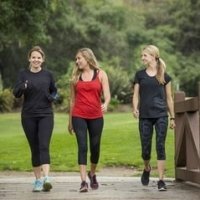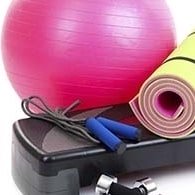Transverse Abdominal Exercises


These transverse abdominal exercises focus primarily on the transverse abdominis muscle, although other muscles will be engaged during some of the workouts. The transverse abdominis muscle is one of the most neglected and forgotten muscles.
It is critical for strengthening the core and minimizing back injury which includes these muscles. There are not too many ab exercises for this deep muscle, however you don't need a wide variety to help tone and strengthen the transverse abdominis.
This is the deepest of the abdominal muscles. By strengthening this muscle, you are helping prevent lower back pain and injuries. This is because this muscle helps stabilize your spine and pelvis.
It is a key component to your core muscles. Core muscles are those that stabilize the spine and pelvis during exercise and activities.
List of Transverse Abdominal Exercises
To see the instructions for all of these transverse abdominal exercises, simply scroll through the page. If you want to view a specific exercise, then use the links below to jump to that one.
- Plank Pose
- Stability Ball Transverse Abdominal Exercises
- Transverse Abdominal Lift
- Scissor Kicks
- Stomach Vacuum
Benefits of Transverse Abdominal Exercises
Many abdominal exercises will inherently activate and strengthen the transverse abdominals but at a lessor extent. To really strengthen this muscle, you want to do workouts that will target it specifically.
While there are not a wide variety of exercises like with crunches, it does not take a wide range of movement to activate the transverse abdominis. In fact, slight movements, such as sucking in your stomach as if you were trying to touch your belly button to your spine, will activate the muscle. This simple movement will contract and strengthen this abdominal muscle.

The fibers of this muscle run horizontally around the abdomen and works as a girdle or belt. Hence the nickname for the transversus abdominis of the "corset muscle". The primary function of this muscle is to compress the ribs and viscera, stabilizing the pelvis and spine. The TrA will help prevent a protruding belly. Basically, it helps hold the stomach in.
While achieving achieving a flatter belly is one of the benefits of strengthening the muscle, preventing lower back injury is a greater benefit. Since this muscle acts as a girdle, or your weight lifting belt if you will, keeping this strong will help you when lifting heavy objects.
It has been estimated that the contraction of the transverse abdominis and other muscles reduces the vertical pressure on the intervertebral discs by as much as 40%. If this muscle is not engaged while lifting, you are more prone to spinal injuries. Working all the core muscles will help minimize back pain and injury.
Plank Pose
The Plank Pose is an isometic exercise which means a non-mover. Instead you will hold the "pose" for a set amount of time to engage and strengthen the transverse abdominal. Your body is positioned as such that you will resemble a plank of wood, hence the name for this exercise. This is also sometimes called the front hold, hover or abdominal bridge.
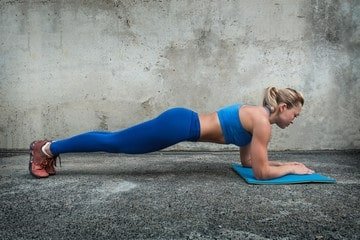
How to do the Plank Pose
- Start by placing your knees and your hands on the ground and sitting in a doggy position with your arms directly underneath your shoulders.
- Now stretch your legs out keeping your back straight and prop the legs up with your toes.
- Look straight down to the floor keeping the neck aligned with your straight back.
- Pull your ab muscles in so the hips don't sag. Don't let the hips rise up, keep them in line with the back. The body should form a straight line from your heels to the top of the head.
- Now hold this pose for about 30 seconds or longer.
- Release the hold by placing your knees back on the mat.
- Repeat for several repititions of this isometric exercise.
These are the steps for the front plank pose. There are other plank pose transverse abdominal exercises such as the side plank and reverse plank.
Stability Ball Transverse Abdominal Exercises
With this workout you will find three different exercises to strengthen that deep abdominal muscle. There are step by step instructions for each of the three different moves.

How to do the Pilates 100
The first of the three is the pilates 100 but done using the exercise ball. While your arms are moving with this one, your abdominal muscles stay contracted as you hold your position.
- Lay down on the mat and place your feet on top of the exercise ball. Make sure your legs are fully extended.
- Place your arms by your side and lift your hips up off the floor.
- Raise your head up off the mat and pull your shoulders forward.
- Hold this position and pump your arms up and down while you hold your body in position. Do 100 pumps with your arms. Make sure to breath during this exercise.
How to do the Toe Drop
The second of the stability ball moves is the toe drop. This one is an isotonic, or mover, exercise. Make sure to inhale as you lower the ball and exhale as you bring the ball back up.
- Remain laying down on the mat with arms straight at your sides. Grab the ball with your feet keeping your back to the mat.
- Lift your legs bending at the knees until your knees are pointed to the ceiling and your legs are at a 90 degree angle. This is your starting position.
- Now slowly lower lower your legs to the floor keeping your knees bent until the ball has touched the mat.
- Raise the legs back up to the starting position always keeping your knees at the 90 degree angle.
- Repeat this for about 20 reps breathing in when you lower and exhale when you lift up.
How to do the Knee Drop
The last of these transverse ab workout is the knee drop. Just as the name suggests, you will be dropping your knees (while holding the stability ball with your legs) down to the mat. This last exercise with the stability ball also engages the oblique muscles.
- Begin in the same starting position as the toe drop (exercise 2b) but extend your arms out and place your palms on the floor.
- Slowly drop the ball down to the right.
- Bring the ball back to the center and then slowly drop to the other side.
- Repeat this for several repetitions.
Performing all three of these transverse abdominal exercises with the stability ball will give your deep abdominal muscles a great workout.
Transverse Abdominal Lift
This particular transverse abdominal exercise is small movements but very effective. You can do this with or without a ball. The instructions is without a ball. If you want to use a ball, place it under your hips and stretch your arms out to the sides.
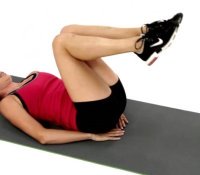
How to do the Transverse Abdominal Lift
- Lay down on the mat and place your hands under your hips.
- Place your shoulders and feet on the mat with your knees bent at a 90 degree angle.
- Lift your knees up right above the hip keeping the knees bent.
- Lift your head slightly up off the mat.
- Pull your rib cage down into the mat. This will engage the transverse abdominal muscle. This is your starting position.
- Lift the tail bone slightly and then slowly return to starting position.
- Repeat this for several repetitions.
Remember this transverse abdominal exercise is small in movements. You don't have to lift very far in order to engage the transverse abdominal muscle.
Scissor Kicks
Your legs will make a scissor like movement with this exercise, hence it's name. This exercise is one that engages the transverse abdominals as well as the rectus abdominis and obliques. So this one exercise is a full abdominal workout. You want to ensure that you do this one correctly otherwise you could be putting some strain on your lower back.
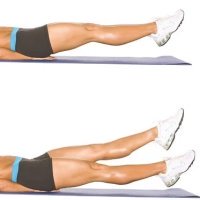
How to do the Scissor Kicks
- Lay down on the mat and place your hands, palms down, under your glutes with knees bent and feet on the floor.
- Now stretch your legs straight out keeping your upper body stable and flat to the floor.
- Lift your feet off the ground about 3 inches with toes pointed (or flexed for more challenge). Lift higher for beginners and bend at the knees.
- Alternating legs, kick your legs up and down. So one leg goes up and the other goes down simultaneously.
- Make sure to breath as you do this exercise. Do this for several kicks and then relax.
- Repeat for a couple more sets.
This stomach exercise can be easily adapted for your fitness levels. Beginners can keep their legs at a 45 degree angle and their knees bent. The lower your legs and the straighter, the more advanced the workout. You can also either point your toes or flex the toes when doing this move. By flexing, you are adding more challenge and working those muscles harder.
Stomach Vacuum
The last of the transverse abdominal exercises on is the stomach vacuum. This abdominal workout gets it's name due to the sucking in, like a vacuum, of your belly. By sucking in you are contracting the abdominals and building the strength.
How to do the Stomach Vacuum
- Stand with your feet shoulder width apart.
- Place a hand on your stomach to help gage that you are doing this correctly.
- Place your other hand behind you at the lower back.
- Now inhale as much air as possible.
- Next exhale and bring in your stomach in as far as you can as if your belly button is touching your back bone.
- Hold this contraction for around 20 seconds.
- During the hold, make sure to breath normally.
- Return to starting position. Repeat for several times.
Beginners may find this easier to do laying down face up on a mat with their back to the floor. You can do this in a sitting position, while at your work desk or watching television but you will get the best results standing up.
In addition to these transverse abdominal exercises, try these abdominal crunches to work other areas of your ab muscles.
Featured Articles
Additional Articles
Lose Belly Fat
Doing abdominal exercises is great to tighten and tone the stomach. However,
if you have a layer of fat hiding those muscles, then you want to lose
that belly fat. Learn what it really takes to shed the fat and get a flat stomach.
Best Ab Exercises
Find out the results of one study of 13 common abdominal exercises and
see which ones made the top of the list.
Arm, Wrist and Ankle Stretches
Check out these exercise instructions to stretch your arms, wrists and ankles. These can all be done while sitting down.

